Research Proposal: Chicago Youth, Methamphetamine, and BMI Study
VerifiedAdded on 2022/12/28
|6
|1479
|95
Report
AI Summary
This research proposal investigates the relationship between sexual orientation, body mass index (BMI), and methamphetamine use among Chicago youth. The study aims to conduct a quantitative cross-sectional study using secondary data to explore the correlation between these factors. The proposal highlights the existing evidence suggesting a link between sexual orientation and methamphetamine use, particularly among gay men, and the prevalence of obesity and substance abuse in Chicago. It emphasizes the need for this research to address health disparities within the sexual minority population and inform the development of targeted policies. The background section reviews literature on obesity, substance abuse, and their interplay, as well as the influence of sexual orientation on health outcomes. The study seeks to identify whether sexual orientation influences the relationship between BMI and methamphetamine use and to understand the health challenges faced by the youth population.
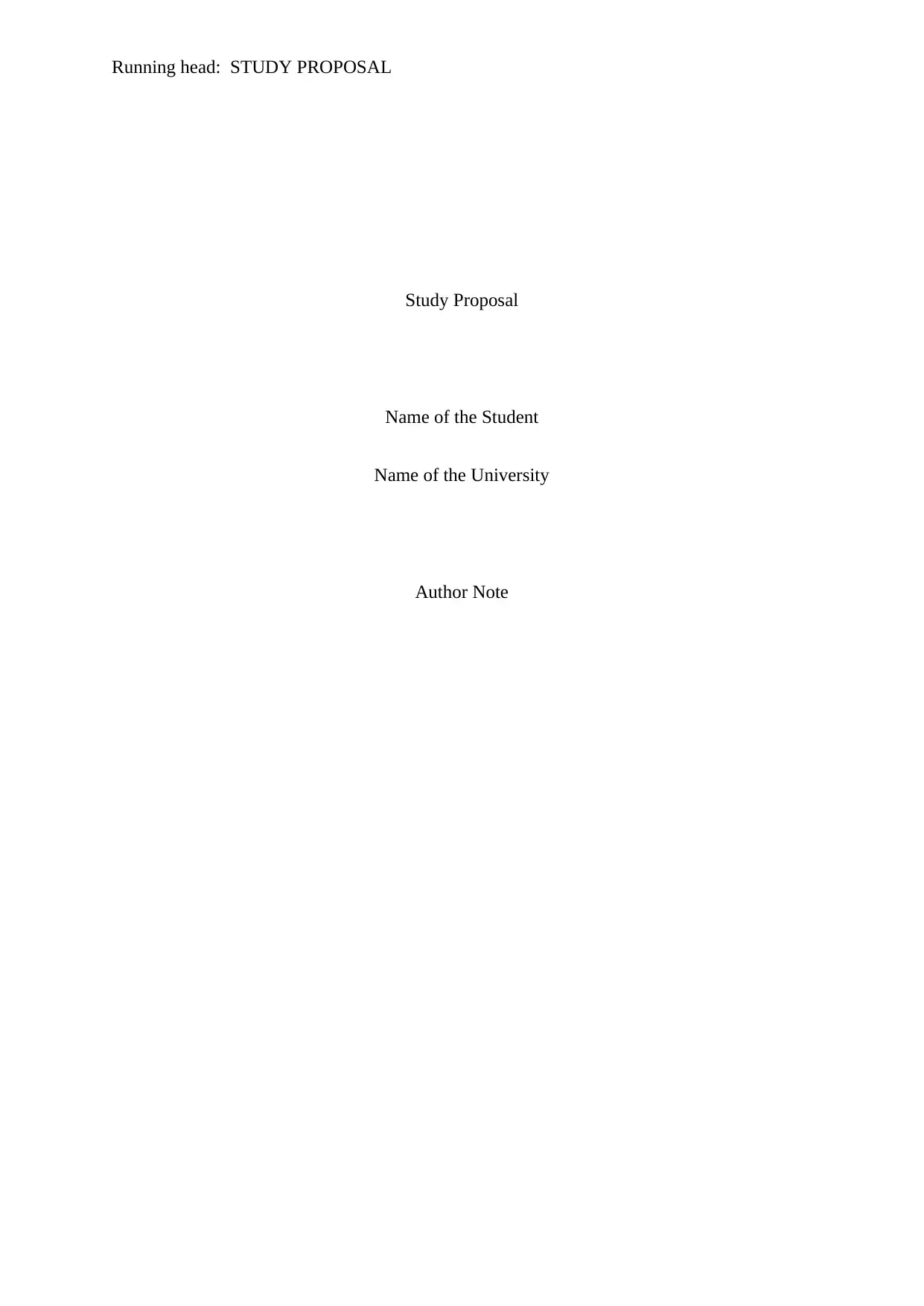
Running head: STUDY PROPOSAL
Study Proposal
Name of the Student
Name of the University
Author Note
Study Proposal
Name of the Student
Name of the University
Author Note
Paraphrase This Document
Need a fresh take? Get an instant paraphrase of this document with our AI Paraphraser
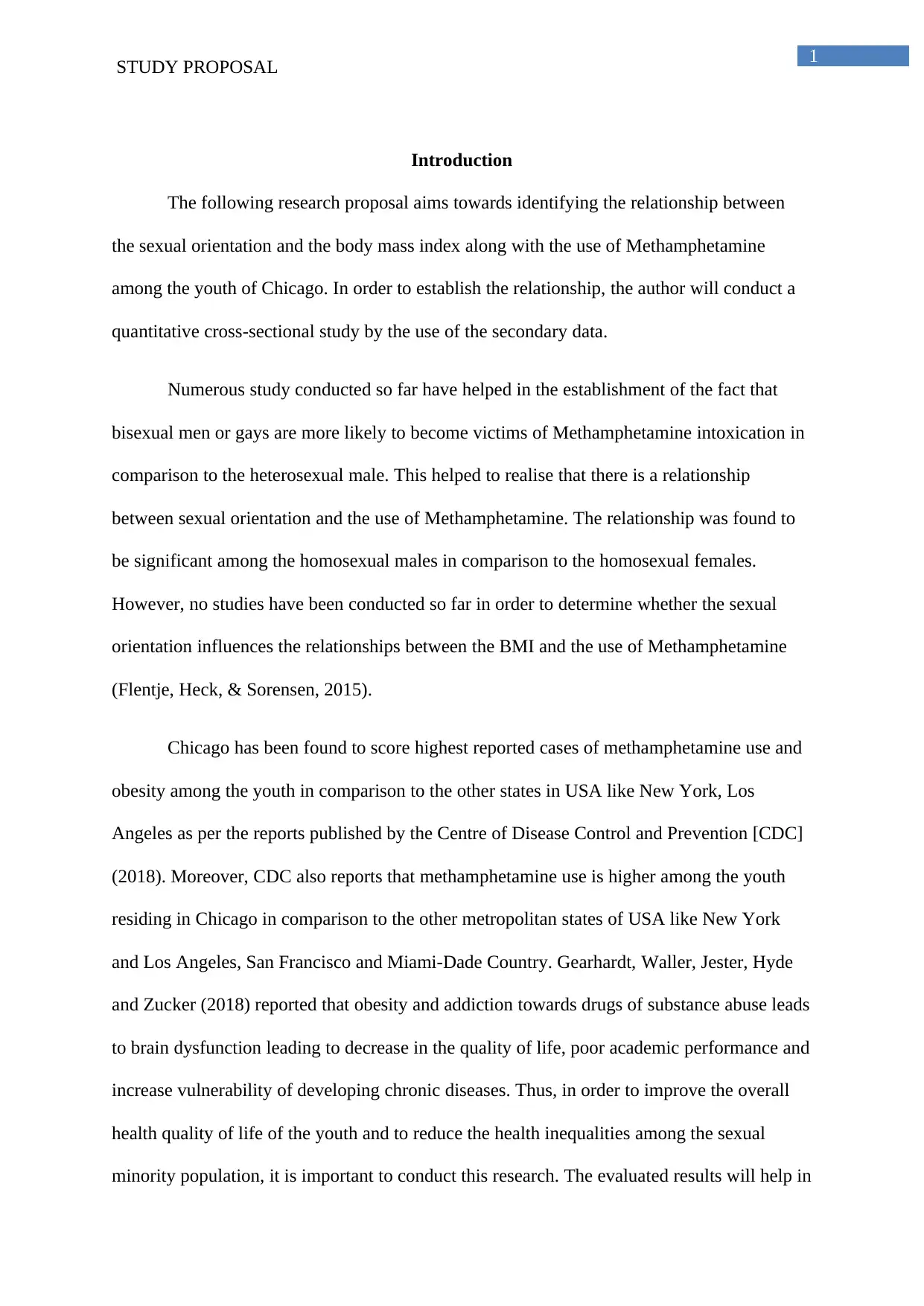
1
STUDY PROPOSAL
Introduction
The following research proposal aims towards identifying the relationship between
the sexual orientation and the body mass index along with the use of Methamphetamine
among the youth of Chicago. In order to establish the relationship, the author will conduct a
quantitative cross-sectional study by the use of the secondary data.
Numerous study conducted so far have helped in the establishment of the fact that
bisexual men or gays are more likely to become victims of Methamphetamine intoxication in
comparison to the heterosexual male. This helped to realise that there is a relationship
between sexual orientation and the use of Methamphetamine. The relationship was found to
be significant among the homosexual males in comparison to the homosexual females.
However, no studies have been conducted so far in order to determine whether the sexual
orientation influences the relationships between the BMI and the use of Methamphetamine
(Flentje, Heck, & Sorensen, 2015).
Chicago has been found to score highest reported cases of methamphetamine use and
obesity among the youth in comparison to the other states in USA like New York, Los
Angeles as per the reports published by the Centre of Disease Control and Prevention [CDC]
(2018). Moreover, CDC also reports that methamphetamine use is higher among the youth
residing in Chicago in comparison to the other metropolitan states of USA like New York
and Los Angeles, San Francisco and Miami-Dade Country. Gearhardt, Waller, Jester, Hyde
and Zucker (2018) reported that obesity and addiction towards drugs of substance abuse leads
to brain dysfunction leading to decrease in the quality of life, poor academic performance and
increase vulnerability of developing chronic diseases. Thus, in order to improve the overall
health quality of life of the youth and to reduce the health inequalities among the sexual
minority population, it is important to conduct this research. The evaluated results will help in
STUDY PROPOSAL
Introduction
The following research proposal aims towards identifying the relationship between
the sexual orientation and the body mass index along with the use of Methamphetamine
among the youth of Chicago. In order to establish the relationship, the author will conduct a
quantitative cross-sectional study by the use of the secondary data.
Numerous study conducted so far have helped in the establishment of the fact that
bisexual men or gays are more likely to become victims of Methamphetamine intoxication in
comparison to the heterosexual male. This helped to realise that there is a relationship
between sexual orientation and the use of Methamphetamine. The relationship was found to
be significant among the homosexual males in comparison to the homosexual females.
However, no studies have been conducted so far in order to determine whether the sexual
orientation influences the relationships between the BMI and the use of Methamphetamine
(Flentje, Heck, & Sorensen, 2015).
Chicago has been found to score highest reported cases of methamphetamine use and
obesity among the youth in comparison to the other states in USA like New York, Los
Angeles as per the reports published by the Centre of Disease Control and Prevention [CDC]
(2018). Moreover, CDC also reports that methamphetamine use is higher among the youth
residing in Chicago in comparison to the other metropolitan states of USA like New York
and Los Angeles, San Francisco and Miami-Dade Country. Gearhardt, Waller, Jester, Hyde
and Zucker (2018) reported that obesity and addiction towards drugs of substance abuse leads
to brain dysfunction leading to decrease in the quality of life, poor academic performance and
increase vulnerability of developing chronic diseases. Thus, in order to improve the overall
health quality of life of the youth and to reduce the health inequalities among the sexual
minority population, it is important to conduct this research. The evaluated results will help in
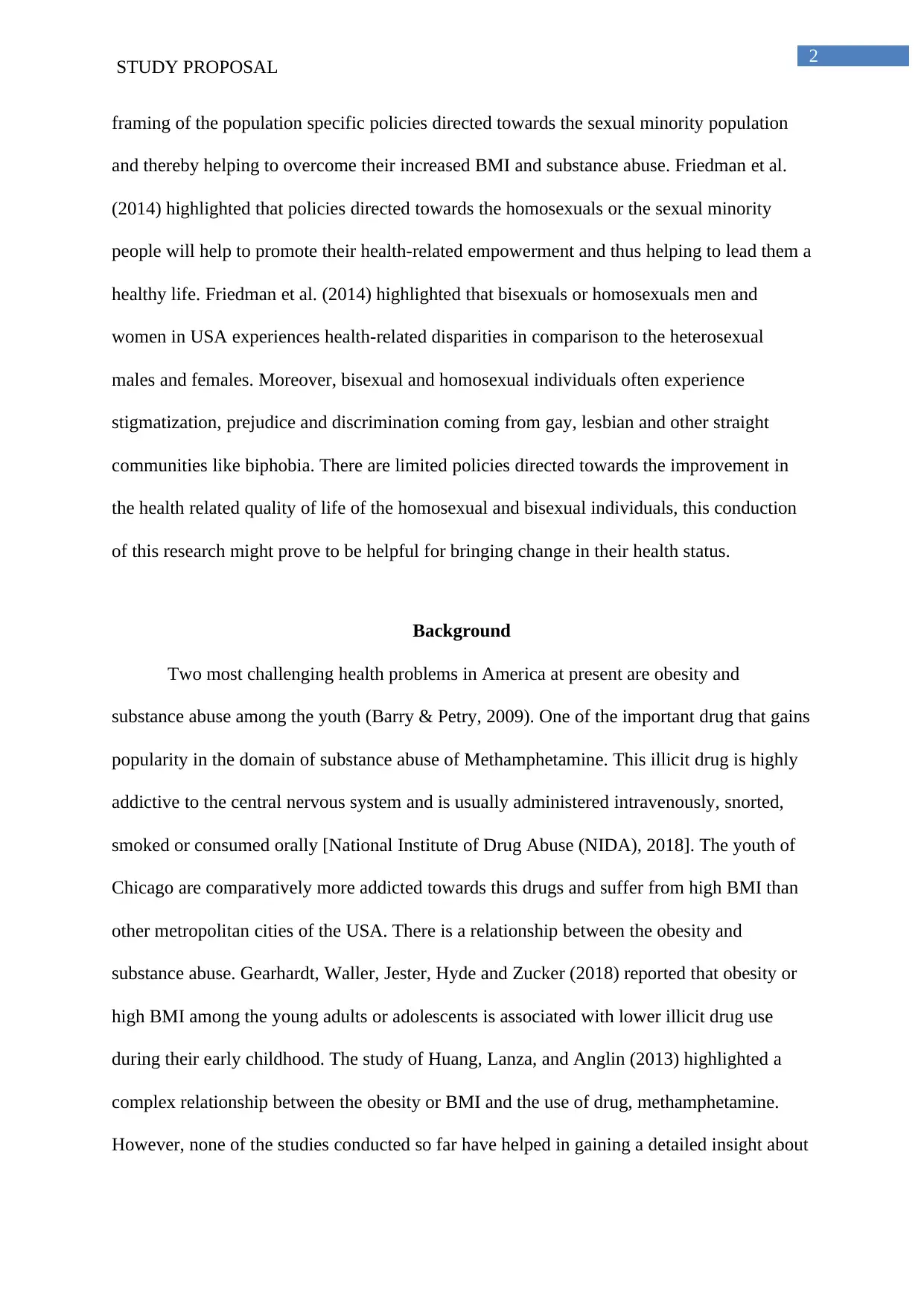
2
STUDY PROPOSAL
framing of the population specific policies directed towards the sexual minority population
and thereby helping to overcome their increased BMI and substance abuse. Friedman et al.
(2014) highlighted that policies directed towards the homosexuals or the sexual minority
people will help to promote their health-related empowerment and thus helping to lead them a
healthy life. Friedman et al. (2014) highlighted that bisexuals or homosexuals men and
women in USA experiences health-related disparities in comparison to the heterosexual
males and females. Moreover, bisexual and homosexual individuals often experience
stigmatization, prejudice and discrimination coming from gay, lesbian and other straight
communities like biphobia. There are limited policies directed towards the improvement in
the health related quality of life of the homosexual and bisexual individuals, this conduction
of this research might prove to be helpful for bringing change in their health status.
Background
Two most challenging health problems in America at present are obesity and
substance abuse among the youth (Barry & Petry, 2009). One of the important drug that gains
popularity in the domain of substance abuse of Methamphetamine. This illicit drug is highly
addictive to the central nervous system and is usually administered intravenously, snorted,
smoked or consumed orally [National Institute of Drug Abuse (NIDA), 2018]. The youth of
Chicago are comparatively more addicted towards this drugs and suffer from high BMI than
other metropolitan cities of the USA. There is a relationship between the obesity and
substance abuse. Gearhardt, Waller, Jester, Hyde and Zucker (2018) reported that obesity or
high BMI among the young adults or adolescents is associated with lower illicit drug use
during their early childhood. The study of Huang, Lanza, and Anglin (2013) highlighted a
complex relationship between the obesity or BMI and the use of drug, methamphetamine.
However, none of the studies conducted so far have helped in gaining a detailed insight about
STUDY PROPOSAL
framing of the population specific policies directed towards the sexual minority population
and thereby helping to overcome their increased BMI and substance abuse. Friedman et al.
(2014) highlighted that policies directed towards the homosexuals or the sexual minority
people will help to promote their health-related empowerment and thus helping to lead them a
healthy life. Friedman et al. (2014) highlighted that bisexuals or homosexuals men and
women in USA experiences health-related disparities in comparison to the heterosexual
males and females. Moreover, bisexual and homosexual individuals often experience
stigmatization, prejudice and discrimination coming from gay, lesbian and other straight
communities like biphobia. There are limited policies directed towards the improvement in
the health related quality of life of the homosexual and bisexual individuals, this conduction
of this research might prove to be helpful for bringing change in their health status.
Background
Two most challenging health problems in America at present are obesity and
substance abuse among the youth (Barry & Petry, 2009). One of the important drug that gains
popularity in the domain of substance abuse of Methamphetamine. This illicit drug is highly
addictive to the central nervous system and is usually administered intravenously, snorted,
smoked or consumed orally [National Institute of Drug Abuse (NIDA), 2018]. The youth of
Chicago are comparatively more addicted towards this drugs and suffer from high BMI than
other metropolitan cities of the USA. There is a relationship between the obesity and
substance abuse. Gearhardt, Waller, Jester, Hyde and Zucker (2018) reported that obesity or
high BMI among the young adults or adolescents is associated with lower illicit drug use
during their early childhood. The study of Huang, Lanza, and Anglin (2013) highlighted a
complex relationship between the obesity or BMI and the use of drug, methamphetamine.
However, none of the studies conducted so far have helped in gaining a detailed insight about
⊘ This is a preview!⊘
Do you want full access?
Subscribe today to unlock all pages.

Trusted by 1+ million students worldwide
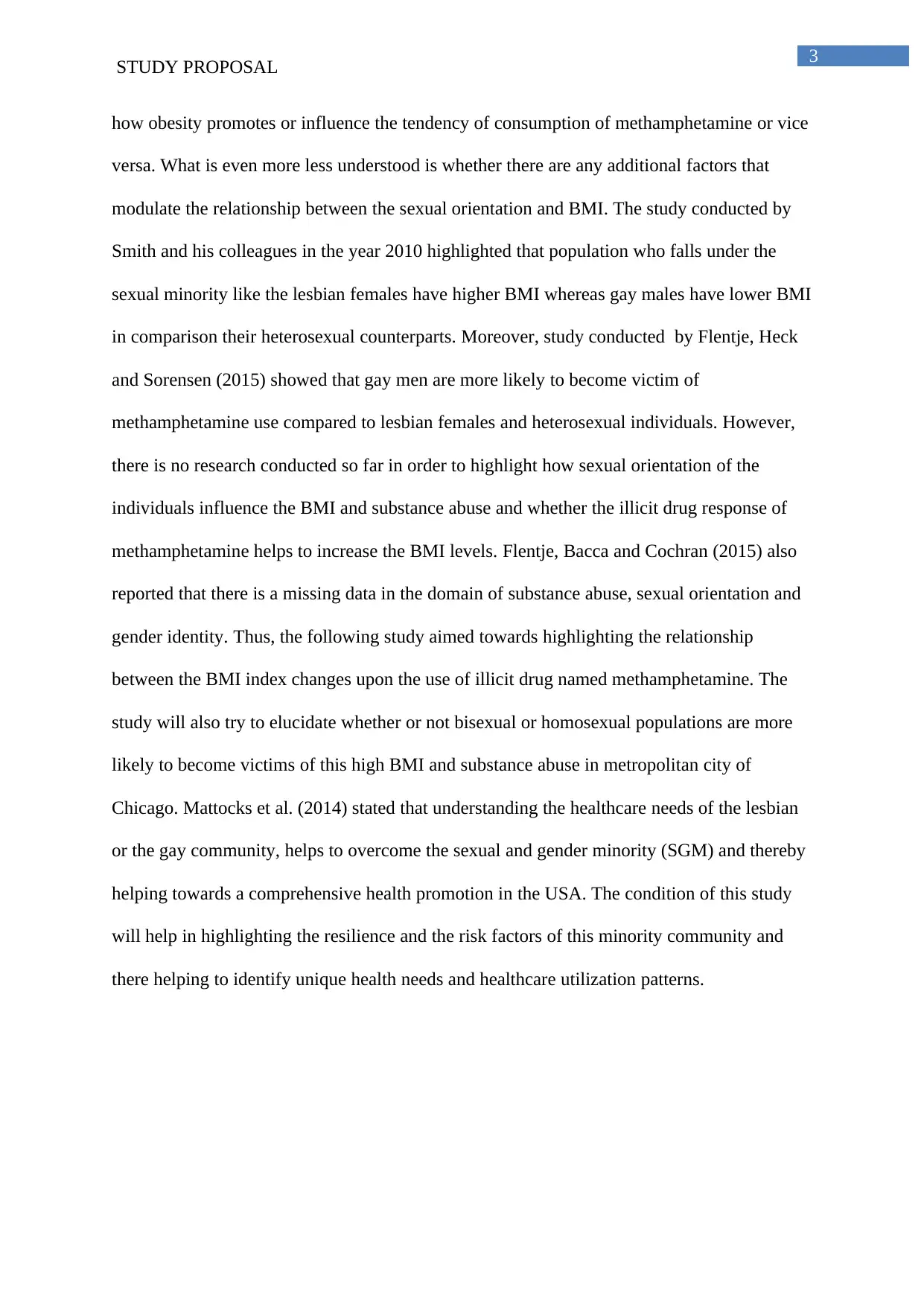
3
STUDY PROPOSAL
how obesity promotes or influence the tendency of consumption of methamphetamine or vice
versa. What is even more less understood is whether there are any additional factors that
modulate the relationship between the sexual orientation and BMI. The study conducted by
Smith and his colleagues in the year 2010 highlighted that population who falls under the
sexual minority like the lesbian females have higher BMI whereas gay males have lower BMI
in comparison their heterosexual counterparts. Moreover, study conducted by Flentje, Heck
and Sorensen (2015) showed that gay men are more likely to become victim of
methamphetamine use compared to lesbian females and heterosexual individuals. However,
there is no research conducted so far in order to highlight how sexual orientation of the
individuals influence the BMI and substance abuse and whether the illicit drug response of
methamphetamine helps to increase the BMI levels. Flentje, Bacca and Cochran (2015) also
reported that there is a missing data in the domain of substance abuse, sexual orientation and
gender identity. Thus, the following study aimed towards highlighting the relationship
between the BMI index changes upon the use of illicit drug named methamphetamine. The
study will also try to elucidate whether or not bisexual or homosexual populations are more
likely to become victims of this high BMI and substance abuse in metropolitan city of
Chicago. Mattocks et al. (2014) stated that understanding the healthcare needs of the lesbian
or the gay community, helps to overcome the sexual and gender minority (SGM) and thereby
helping towards a comprehensive health promotion in the USA. The condition of this study
will help in highlighting the resilience and the risk factors of this minority community and
there helping to identify unique health needs and healthcare utilization patterns.
STUDY PROPOSAL
how obesity promotes or influence the tendency of consumption of methamphetamine or vice
versa. What is even more less understood is whether there are any additional factors that
modulate the relationship between the sexual orientation and BMI. The study conducted by
Smith and his colleagues in the year 2010 highlighted that population who falls under the
sexual minority like the lesbian females have higher BMI whereas gay males have lower BMI
in comparison their heterosexual counterparts. Moreover, study conducted by Flentje, Heck
and Sorensen (2015) showed that gay men are more likely to become victim of
methamphetamine use compared to lesbian females and heterosexual individuals. However,
there is no research conducted so far in order to highlight how sexual orientation of the
individuals influence the BMI and substance abuse and whether the illicit drug response of
methamphetamine helps to increase the BMI levels. Flentje, Bacca and Cochran (2015) also
reported that there is a missing data in the domain of substance abuse, sexual orientation and
gender identity. Thus, the following study aimed towards highlighting the relationship
between the BMI index changes upon the use of illicit drug named methamphetamine. The
study will also try to elucidate whether or not bisexual or homosexual populations are more
likely to become victims of this high BMI and substance abuse in metropolitan city of
Chicago. Mattocks et al. (2014) stated that understanding the healthcare needs of the lesbian
or the gay community, helps to overcome the sexual and gender minority (SGM) and thereby
helping towards a comprehensive health promotion in the USA. The condition of this study
will help in highlighting the resilience and the risk factors of this minority community and
there helping to identify unique health needs and healthcare utilization patterns.
Paraphrase This Document
Need a fresh take? Get an instant paraphrase of this document with our AI Paraphraser
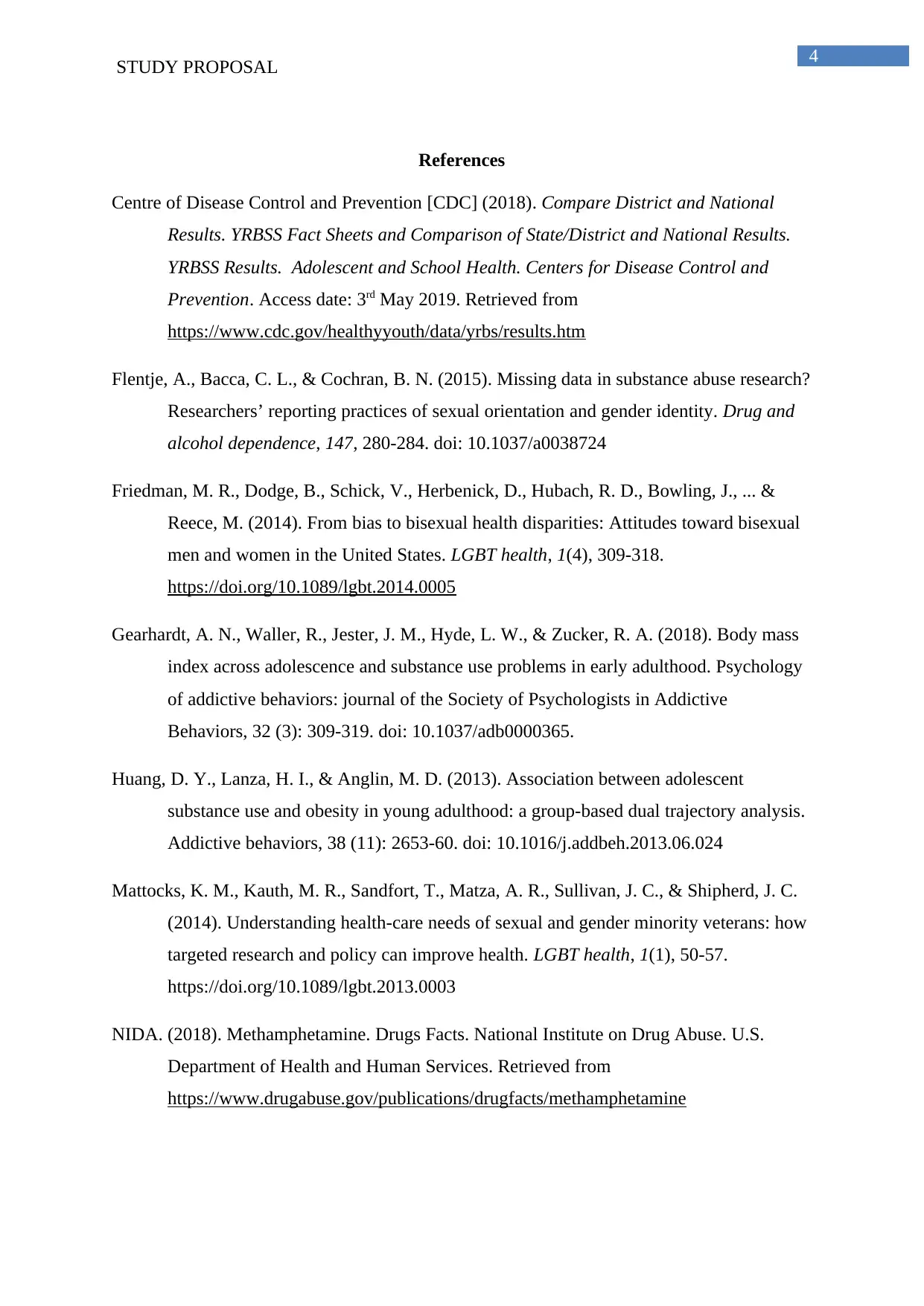
4
STUDY PROPOSAL
References
Centre of Disease Control and Prevention [CDC] (2018). Compare District and National
Results. YRBSS Fact Sheets and Comparison of State/District and National Results.
YRBSS Results. Adolescent and School Health. Centers for Disease Control and
Prevention. Access date: 3rd May 2019. Retrieved from
https://www.cdc.gov/healthyyouth/data/yrbs/results.htm
Flentje, A., Bacca, C. L., & Cochran, B. N. (2015). Missing data in substance abuse research?
Researchers’ reporting practices of sexual orientation and gender identity. Drug and
alcohol dependence, 147, 280-284. doi: 10.1037/a0038724
Friedman, M. R., Dodge, B., Schick, V., Herbenick, D., Hubach, R. D., Bowling, J., ... &
Reece, M. (2014). From bias to bisexual health disparities: Attitudes toward bisexual
men and women in the United States. LGBT health, 1(4), 309-318.
https://doi.org/10.1089/lgbt.2014.0005
Gearhardt, A. N., Waller, R., Jester, J. M., Hyde, L. W., & Zucker, R. A. (2018). Body mass
index across adolescence and substance use problems in early adulthood. Psychology
of addictive behaviors: journal of the Society of Psychologists in Addictive
Behaviors, 32 (3): 309-319. doi: 10.1037/adb0000365.
Huang, D. Y., Lanza, H. I., & Anglin, M. D. (2013). Association between adolescent
substance use and obesity in young adulthood: a group-based dual trajectory analysis.
Addictive behaviors, 38 (11): 2653-60. doi: 10.1016/j.addbeh.2013.06.024
Mattocks, K. M., Kauth, M. R., Sandfort, T., Matza, A. R., Sullivan, J. C., & Shipherd, J. C.
(2014). Understanding health-care needs of sexual and gender minority veterans: how
targeted research and policy can improve health. LGBT health, 1(1), 50-57.
https://doi.org/10.1089/lgbt.2013.0003
NIDA. (2018). Methamphetamine. Drugs Facts. National Institute on Drug Abuse. U.S.
Department of Health and Human Services. Retrieved from
https://www.drugabuse.gov/publications/drugfacts/methamphetamine
STUDY PROPOSAL
References
Centre of Disease Control and Prevention [CDC] (2018). Compare District and National
Results. YRBSS Fact Sheets and Comparison of State/District and National Results.
YRBSS Results. Adolescent and School Health. Centers for Disease Control and
Prevention. Access date: 3rd May 2019. Retrieved from
https://www.cdc.gov/healthyyouth/data/yrbs/results.htm
Flentje, A., Bacca, C. L., & Cochran, B. N. (2015). Missing data in substance abuse research?
Researchers’ reporting practices of sexual orientation and gender identity. Drug and
alcohol dependence, 147, 280-284. doi: 10.1037/a0038724
Friedman, M. R., Dodge, B., Schick, V., Herbenick, D., Hubach, R. D., Bowling, J., ... &
Reece, M. (2014). From bias to bisexual health disparities: Attitudes toward bisexual
men and women in the United States. LGBT health, 1(4), 309-318.
https://doi.org/10.1089/lgbt.2014.0005
Gearhardt, A. N., Waller, R., Jester, J. M., Hyde, L. W., & Zucker, R. A. (2018). Body mass
index across adolescence and substance use problems in early adulthood. Psychology
of addictive behaviors: journal of the Society of Psychologists in Addictive
Behaviors, 32 (3): 309-319. doi: 10.1037/adb0000365.
Huang, D. Y., Lanza, H. I., & Anglin, M. D. (2013). Association between adolescent
substance use and obesity in young adulthood: a group-based dual trajectory analysis.
Addictive behaviors, 38 (11): 2653-60. doi: 10.1016/j.addbeh.2013.06.024
Mattocks, K. M., Kauth, M. R., Sandfort, T., Matza, A. R., Sullivan, J. C., & Shipherd, J. C.
(2014). Understanding health-care needs of sexual and gender minority veterans: how
targeted research and policy can improve health. LGBT health, 1(1), 50-57.
https://doi.org/10.1089/lgbt.2013.0003
NIDA. (2018). Methamphetamine. Drugs Facts. National Institute on Drug Abuse. U.S.
Department of Health and Human Services. Retrieved from
https://www.drugabuse.gov/publications/drugfacts/methamphetamine

5
STUDY PROPOSAL
Smith, H. A., Markovic, N., Danielson, M. E., Matthews, A., Youk, A., Talbott, E.
O., ...Hughes, T. (2010). Sexual abuse, sexual orientation, and obesity in women.
Journal of women's health (2002), 19 (8): 1525-32. doi: 10.1089/jwh.2009.176
STUDY PROPOSAL
Smith, H. A., Markovic, N., Danielson, M. E., Matthews, A., Youk, A., Talbott, E.
O., ...Hughes, T. (2010). Sexual abuse, sexual orientation, and obesity in women.
Journal of women's health (2002), 19 (8): 1525-32. doi: 10.1089/jwh.2009.176
⊘ This is a preview!⊘
Do you want full access?
Subscribe today to unlock all pages.

Trusted by 1+ million students worldwide
1 out of 6
Related Documents
Your All-in-One AI-Powered Toolkit for Academic Success.
+13062052269
info@desklib.com
Available 24*7 on WhatsApp / Email
![[object Object]](/_next/static/media/star-bottom.7253800d.svg)
Unlock your academic potential
Copyright © 2020–2025 A2Z Services. All Rights Reserved. Developed and managed by ZUCOL.





